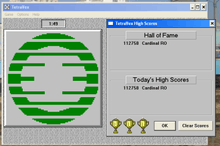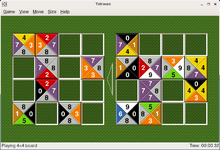TetraVex
TetraVex is a puzzle computer game, available for Windows and Linux systems.
Gameplay
TetraVex is an edge-matching puzzle. The player is presented with a grid (by default, 3x3) and nine square tiles, each with a number on each edge. The objective of the game is to place the tiles in the grid in the proper position as fast as possible. Two tiles can only be placed next to each other if the numbers on adjacent faces match.
Availability
TetraVex was originally available for Windows in Windows Entertainment Pack 3. It was later re-released as part of the Best of Windows Entertainment Pack.
TetraVex is also available as an open source game on the GNOME desktop as part of the GNOME Games collection under GNU GPL.[1]
Origins

The original version of TetraVex (for the Windows Entertainment Pack 3) was written (and named) by Scott Ferguson who was also the Development Lead and an architect of the first version of Visual Basic.[2] TetraVex was inspired by "the problem of tiling the plane" as described by Donald Knuth on page 382 of Volume 1: Fundamental Algorithms, the first book in his The Art of Computer Programming series.
In the TetraVex version for Windows, the Microsoft Blibbet logo is displayed if the player solves a 6 by 6 puzzle as seen in the image to the right.
The tiles are also known as McMahon Squares, named for Percy McMahon who explored their possibilities in the 1920s.[3]
Counting the possible number of TetraVex
On a  board there are
board there are  horizontal and vertical pairs that must match and
horizontal and vertical pairs that must match and  numbers along the edges that can be chosen arbitrarily. Hence there are
numbers along the edges that can be chosen arbitrarily. Hence there are  choices of 10 digits, i.e.
choices of 10 digits, i.e.  possible boards. Deciding if a TetraVex puzzle has a solution is
in general NP-complete.[4]
possible boards. Deciding if a TetraVex puzzle has a solution is
in general NP-complete.[4]
See also
- Eternity II
- Wang tile
References
- ↑ "License - README". gnome-games. gnome.org. 2011. Retrieved 2012-10-02.
- ↑ "The Birth of Visual Basic". Forestmoon.com. Retrieved 2010-05-11.
- ↑ "MacMahon squares". Daviddarling.info. 2007-02-01. Retrieved 2010-07-30.
- ↑ "TetraVex is NP-complete". Information Processing Letters, Volume 99, Issue 5, Pages 171–174. 15 September 2006.
